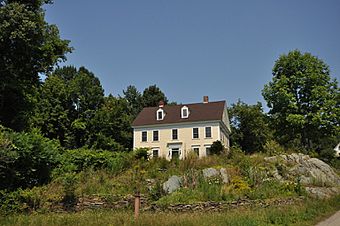David Dexter House facts for kids
Quick facts for kids |
|
|
David Dexter House
|
|
 |
|
| Location | Lincoln Heights, Claremont, New Hampshire |
|---|---|
| Area | less than one acre |
| Built | 1790 |
| Architectural style | Federal |
| NRHP reference No. | 79000213 |
| Added to NRHP | November 29, 1979 |
The David Dexter House is a very old and important house located on Lincoln Heights in Claremont, New Hampshire. It was built around 1790. This house is a great example of the Federal style of architecture from that time. It was once the home of David Dexter, who started the first mills in Claremont. These mills were very important to the city's early industrial history.
The house was moved in 1975 to save it from being torn down. It was then added to the National Register of Historic Places in 1979. Today, the David Dexter House has been changed into apartments.
What Makes This House Special?
The David Dexter House sits on a small hill called Lincoln Heights. This area is north of the Sugar River, where Bridge Street crosses it. The house is made of wood and has two and a half stories. It has a pointed roof and its outside walls are covered with wooden boards called clapboards.
Even though the house is not in its first spot, it now rests on a new foundation. This new foundation even includes some granite blocks from its original base. The front of the house has five windows across and the house is four windows deep. The windows are placed in a balanced way around the main entrance. The windows on the first floor have decorative tops. The front door has a fancy frame in the Federal style. Inside, the house also has beautiful details from the Federal period, especially the main staircase.
The History of the David Dexter House
David Dexter built this house around 1790. He and his brother, Stephen, started the very first mills on the Sugar River in Claremont. These mills were built on land that later became known as the Monadnock Mills. The David Dexter House was originally located much closer to the river.
Later on, the house was used as a place for mill workers to live. In the 1970s, the house became the center of a big discussion about saving old buildings. Because of this, the house was carefully moved to its current spot in 1975. A newer part of the house and its original chimney were removed before the move. This move helped save the house from a city plan that would have torn it down.



